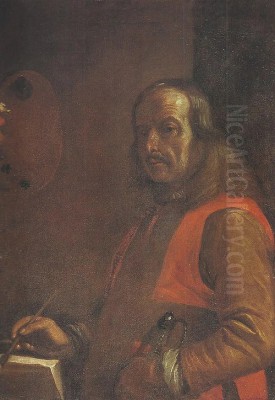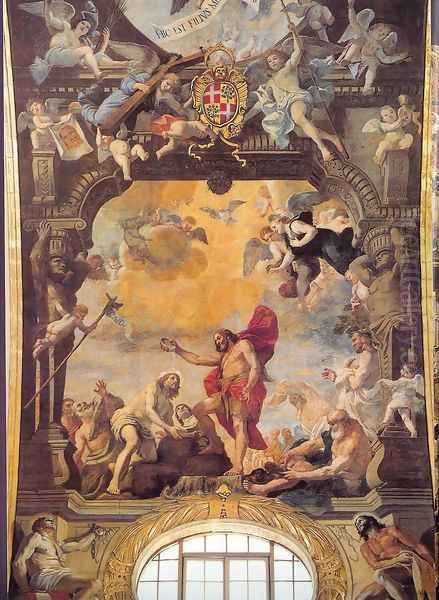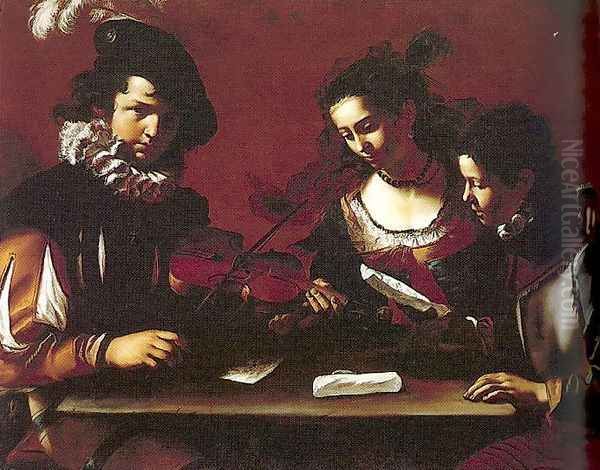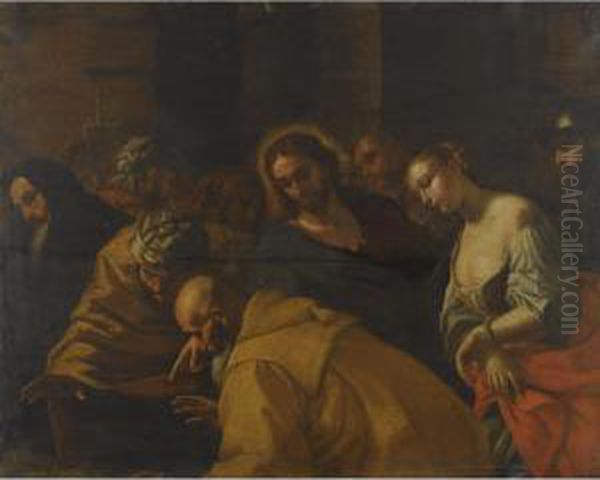
Mattia Preti stands as a towering figure in the landscape of 17th-century Italian art. Born in the small town of Taverna in Calabria in 1613, and passing away in Valletta, Malta, in 1699, his long and remarkably productive life spanned a crucial period of artistic development. Known affectionately and respectfully as "Il Cavalier Calabrese" (The Calabrian Knight), Preti forged a powerful and distinctive style that bridged the intense realism of Caravaggio with the grandeur and dynamism of the High Baroque, leaving an indelible mark on the artistic scenes of Rome, Naples, and especially Malta. His journey reflects not only personal artistic evolution but also the shifting cultural and religious currents of his time.
Early Life and Roman Formation
Mattia Preti's artistic journey began not in his native Calabria, but in the bustling artistic crucible of Rome. Around 1630, he moved to the papal city, likely accompanied by his elder brother Gregorio Preti, who was also a painter. Rome in the 1630s was still reverberating with the revolutionary impact of Michelangelo Merisi da Caravaggio, who had died two decades earlier but whose dramatic use of light and shadow (chiaroscuro) and unflinching realism continued to captivate artists. Preti quickly absorbed the lessons of Caravaggio and his followers, the Caravaggisti.
The influence of key Caravaggisti is evident in Preti's early works. Artists such as Bartolomeo Manfredi, known for his tavern scenes and depictions of everyday life infused with Caravaggesque drama, and the French painter Valentin de Boulogne, who excelled at similar themes with a distinct psychological depth, provided models for the young Preti. The powerful, often gritty realism of the Spanish painter Jusepe de Ribera, active primarily in Naples but whose influence radiated outwards, also seems to have resonated with Preti's developing sensibilities. Some early works may have been collaborations with his brother Gregorio, further immersing him in the practical application of these stylistic trends.

However, Preti was not merely an imitator. Rome offered a vast repository of artistic traditions. He diligently studied the masters of the High Renaissance and the burgeoning Baroque. The rich colours, dynamic compositions, and theatrical flair of the Venetian school, particularly the works of Tintoretto and Paolo Veronese, clearly captured his imagination. Their influence tempered the starkness of Caravaggism, introducing a greater sense of movement and opulence into his work. Furthermore, the Bolognese school, represented by artists like Guercino with his fluid brushwork and emotional warmth, and Domenichino with his classical compositions, provided alternative models of Baroque expression that Preti synthesized into his evolving style. Works like his Martyrdom of St. Andrew from this period showcase this blend of intense Caravaggesque drama with a growing complexity in composition.
The Neapolitan Zenith
Around 1653, Mattia Preti moved south to Naples, a vibrant and tumultuous metropolis that was then one of the largest cities in Europe and a major artistic centre under Spanish rule. This marked the beginning of a particularly fertile period in his career. Naples had its own strong tradition of Caravaggism, spearheaded by artists like Battistello Caracciolo, whose work Preti would have known well. The city provided a fertile ground for Preti's dramatic and emotionally charged style.
His arrival coincided with a period of significant artistic activity, but also tragedy. Preti was in Naples during the devastating plague of 1656, which decimated the population. As a survivor, he was commissioned to paint large votive frescoes on seven city gates, depicting the Virgin Mary and patron saints interceding to end the plague. Though these monumental works are now lost, known only through preparatory sketches and descriptions, they cemented Preti's reputation in the city. They demonstrated his ability to handle large-scale narrative compositions imbued with profound public and religious significance.
During his Neapolitan years (roughly 1653-1660), Preti produced some of his most powerful easel paintings and altarpieces. Works such as the Feast of Absalom exemplify his mature Neapolitan style: complex multi-figure compositions, dramatic lighting that picks out key figures from deep shadow, rich, often sombre colours, and intense psychological drama. He engaged with the leading Neapolitan artists of the day, most notably the incredibly prolific and versatile Luca Giordano, known for his speed and ability to absorb various styles. While distinct in their approaches, both Preti and Giordano contributed significantly to the development of the Neapolitan Late Baroque, characterized by its dynamism, emotional intensity, and decorative richness. Preti's influence would later be felt by subsequent generations of Neapolitan painters, including Francesco Solimena.
Knight Painter in Malta

In 1661, seeking new opportunities and perhaps a different environment, Mattia Preti relocated to the island of Malta, ruled by the Knights of the Order of St. John. This move marked the final and longest chapter of his life, lasting nearly four decades. His arrival was prestigious; he was soon admitted into the Order as a Knight of Grace. This honour not only provided him with status and security but also came with the expectation that he would dedicate his artistic talents to the glory of the Order and the Catholic faith.
Preti's most significant commission, and arguably his magnum opus, was the decoration of the vault of the Conventual Church of St. John (now St. John's Co-Cathedral) in Valletta. Working directly onto the stone surface using oils, he covered the vast barrel vault with scenes from the life of St. John the Baptist, the patron saint of the Order. This immense cycle, executed between 1661 and 1666, is a triumph of Baroque illusionism and narrative power. Figures seem to break through the architectural framework, depicted with dramatic foreshortening (di sotto in sù) against luminous skies, creating a breathtaking spectacle of divine history unfolding above the worshippers.
Beyond the vault, Preti became the dominant artistic force in Malta. He painted numerous altarpieces for the Co-Cathedral itself, including the powerful Martyrdom of St. John the Baptist and the dramatic St. Paul's Shipwreck for the Chapel of the Langue of France. His workshop produced a staggering number of paintings for parish churches throughout Malta and Gozo, as well as for palaces and private collections. He often created replicas or variations of his successful compositions to meet the high demand, ensuring his style permeated the island's artistic landscape.
During his time in Malta, Preti interacted with local artists and craftsmen. The talented Maltese sculptor Melchiorre Cafà, who achieved fame in Rome, was a contemporary, though their direct collaboration might have been limited by Cafà's time spent abroad. Preti's overwhelming presence undoubtedly influenced local painters, such as Stefano Erardi, who attempted to emulate his style, albeit often with less technical mastery. Preti's long stay in Malta somewhat isolated him from the latest developments in mainland Italy, but it also allowed him to consolidate his unique artistic vision, focused on powerful storytelling and devotional intensity.
Artistic Style and Technique

Mattia Preti's art is characterized by its potent blend of drama, realism, and Baroque grandeur. His early grounding in Caravaggism remained a constant feature, evident in his lifelong use of strong chiaroscuro, often evolving into tenebrism where figures emerge dramatically from deep, enveloping shadows. This technique served not just an aesthetic purpose but also heightened the emotional impact and focused the viewer's attention on the core narrative or spiritual message of the work.
Unlike the static, frozen moments often found in early Caravaggisti works, Preti infused his compositions with dynamism and movement, a legacy of his engagement with Venetian and High Baroque masters like Pietro da Cortona and Giovanni Lanfranco. His figures are rarely passive; they gesture, recoil, suffer, or exult with palpable energy. He excelled at complex, multi-figure compositions, arranging crowds and protagonists in dynamic diagonals or swirling patterns that lead the eye through the scene, creating a sense of unfolding drama.
His palette evolved over his career. While early works sometimes show brighter hues, his Neapolitan and Maltese periods often feature a richer, deeper, and sometimes more sombre tonality, punctuated by flashes of intense colour – crimson reds, deep blues, earthy ochres – that add to the emotional weight. His brushwork could be vigorous and expressive, particularly in his large-scale works, conveying a sense of immediacy and passion.
An interesting aspect noted about Preti's working method is his apparent preference for painting directly, perhaps working from compositional sketches but often developing the final image on the canvas itself, rather than relying on detailed preparatory drawings for every figure. This approach might account for the vitality and occasional raw energy found in his paintings, suggesting a direct translation of his imaginative vision onto the canvas. His art perfectly aligned with the aims of the Counter-Reformation, seeking to inspire faith and piety through emotionally engaging and visually spectacular depictions of religious narratives.
Major Works and Themes
Mattia Preti's vast output encompasses a range of subjects, but he primarily focused on religious and historical themes, reflecting the demands of his patrons, the Church and the Knights of St. John. Certain themes recur, allowing us to trace his stylistic development and thematic preoccupations.

The Martyrdom of St. John the Baptist was a subject Preti revisited multiple times, most famously in the altarpiece for the Chapel of the Langue of France in St. John's Co-Cathedral. These depictions are typically charged with intense drama, focusing on the moments just before or after the execution, exploring themes of faith, sacrifice, and the brutality of power. His treatment of the subject showcases his mastery of chiaroscuro and emotional expression.
Biblical feasts provided another opportunity for complex narrative scenes. The Feast of Absalom, painted during his Neapolitan period, is a prime example, depicting the dramatic moment of Amnon's assassination during the banquet. It allowed Preti to combine rich still-life elements with intense human drama and dynamic figure arrangement. Similarly, works depicting the Feast of Herod often accompany his St. John paintings.
Scenes from the lives of saints were central to his work, particularly in Malta. The entire cycle of the Life of St. John the Baptist on the Co-Cathedral vault is his most extensive narrative achievement. Individual altarpieces depicting key moments like the Baptism of Christ or specific martyrdoms, such as the Martyrdom of St. Catherine or the Martyrdom of St. Paul, are numerous. The St. Paul's Shipwreck in Valletta vividly portrays the patron saint of Malta's arrival on the island, a subject of great local importance.
Other significant works include The Glory of St. Barbara, The Martyrdom of St. Andrew, and numerous depictions of Christ's passion, miracles, and parables. He also painted mythological subjects and allegorical scenes, though less frequently than religious narratives. Throughout these varied themes, Preti consistently brought a sense of gravitas, emotional depth, and theatrical power to his canvases.
Legacy and Influence
Mattia Preti's legacy is substantial and multifaceted. He was a pivotal figure in the transition from the early Baroque's intense naturalism to the High Baroque's dynamic grandeur. His ability to synthesize the light of Caravaggio, the colour of Venice, and the compositional energy of Roman and Neapolitan Baroque created a style that was both powerful and influential.
In Naples, he played a crucial role in shaping the city's distinctive Late Baroque style, influencing painters like Luca Giordano and, later, Francesco Solimena. His dramatic compositions and rich palette became hallmarks of the Neapolitan school. His influence extended beyond Naples, as his works were sought after throughout Italy and beyond.

His impact on Malta was transformative and enduring. Arriving as an established master, he dominated the island's art scene for nearly four decades. He not only created masterpieces that remain central to Malta's cultural heritage, particularly within St. John's Co-Cathedral, but he also elevated the standard of artistic production and influenced generations of Maltese artists, like Stefano Erardi and potentially others within his large workshop. His prolific output ensured that his style became deeply ingrained in the visual culture of the Maltese islands.
Today, Mattia Preti is recognized as one of the major painters of the Italian Baroque. His works are held in high esteem in major museums worldwide, including the Louvre in Paris, the Prado in Madrid, the Metropolitan Museum of Art in New York, and the Victoria and Albert Museum in London, alongside countless churches and collections in Italy and Malta. His nickname, "Il Cavalier Calabrese," continues to evoke the image of a noble artist whose life and work were dedicated to the dramatic portrayal of faith and human experience. His long career, spanning diverse artistic centres and culminating in his dedicated service to the Knights of St. John, secured his place as a unique and significant master of the 17th century.
Conclusion
Mattia Preti's artistic journey from Calabria to Rome, Naples, and finally Malta, charts a course through the heart of the Italian Baroque. He was a master synthesizer, absorbing the stark drama of Caravaggio, the vibrant colour of the Venetians, and the dynamic energy of the High Baroque, forging a style uniquely his own. As Il Cavalier Calabrese, he served the Knights of St. John with unparalleled dedication, leaving Malta endowed with a treasure trove of sacred art, most notably the breathtaking vault of St. John's Co-Cathedral. A painter of profound emotional depth, narrative skill, and technical brilliance, Preti remains a vital figure for understanding the power and complexity of 17th-century European art, a storyteller in paint whose dramatic visions continue to resonate centuries later.